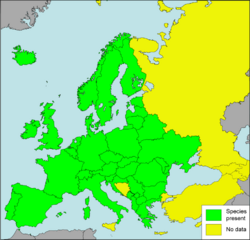Biology:Zonitoides nitidus
| Zonitoides nitidus | |
|---|---|

| |
| Two shells of Zonitoides nitidus | |
| Scientific classification | |
| Domain: | Eukaryota |
| Kingdom: | Animalia |
| Phylum: | Mollusca |
| Class: | Gastropoda |
| Subclass: | Heterobranchia |
| Order: | Stylommatophora |
| Superfamily: | Gastrodontoidea |
| Family: | Gastrodontidae |
| Genus: | Zonitoides |
| Species: | Z. nitidus
|
| Binomial name | |
| Zonitoides nitidus (Müller, 1774)[1]
| |
| Synonyms | |
| |
Zonitoides nitidus (sometimes Zonitoides nitida)[2] is a species of small, air-breathing land snail, a terrestrial pulmonate gastropod mollusc in the family Gastrodontidae.[3]
Zonitoides nitidus is the type species of the genus Zonitoides.
Distribution
The distribution of Zonitoides nitidus includes the Holarctic zone. It is found almost all over Europe except the southernmost regions:[4]
- Czech Republic - least concern (LC)[5]
- Netherlands[6]
- Russia - Sverdlovsk oblast[7]
- Ukraine[8]
- Slovakia
- Great Britain - north British highland zones and not in north Scotland.[4] In some regions in Britain the species has declined due to drainage.[4]
- Ireland
- Hebrides[4]
- Orkney[4]
- Shetland[4]
- rare in northern Greece[4]
- Canada
The non-indigenous distribution of this species includes:
- introduced to Menorca[4]
Description
The shell is reddish brown.[4] The umbilicus is large (almost 25% of shell diameter).[4] The shell is with radial growth lines.[4] The width of the shell is 6–7 mm.[4] The height of the shell is 3.5-4.0 mm.[4]
The animal is black with a characteristic orange dash: the (mantle gland is visible under the shell's aperture).[4]
Juveniles are whitish grey with light brown translucent shells.[4]
Ecology
Zonitoides nitidus occurs in wet meadows and river woods, usually near water bodies, swamps and swampy forests, in the zone of emergent vegetation.[4] Man-made habitats such as pools in old quarries are sometimes colonized after a few years.[4] In Switzerland it is found up to 2100m of altitude.[4]
Zonitoides nitidus is herbivorous.[4] These snails feed on disintegrating leaves, mushrooms, roots and fruit.[4] They do not eat dry leaves.[4] Humid leaves are preferred.[4] When consuming soft food such as mushrooms or soft fruits, Zonitoides nitidus penetrates perpendicularly inside, producing characteristic holes; the entire animal including its shell can penetrate inside the fruit.[4]
In Germany up to three clutches of 2-9 eggs per individual are laid in all seasons, with some days or weeks spacing between egg-laying.[4] Egg diameter is 1.0-1.6 mm.[4] Eggs are laid loose into the soil.[4] Juveniles have 1.5 whorls (diameter 1-1.2 mm) after hatching.[4] They start feeding on disintegrating plant remains in the soil.[4] After 3 months the shell diameter reaches up to 3 mm under favourable conditions, after 10 months 6 mm, and full size after slightly more than one year.[4] Maximum age is 18 months under laboratory conditions.[4]
Parasites of Zonitoides nitidus include:
References
This article incorporates public domain text from the reference.[4]
- ↑ Müller O. F. 1774. Vermivm terrestrium et fluviatilium, seu animalium infusoriorum, helminthicorum, et testaceorum, non marinorum, succincta historia. Volumen alterum. pp. I-XXVI [= 1-36], 1-214, [1-10]. Havniæ & Lipsiæ. (Heineck & Faber).
- ↑ "Zonitoides nitida". Utah Division of Wildlife Resources. https://dwrcdc.nr.utah.gov/rsgis2/search/Display.asp?FlNm=zoniniti.
- ↑ MolluscaBase eds. (2023). MolluscaBase. Zonitoides nitidus (O. F. Müller, 1774). Accessed through: World Register of Marine Species at: https://www.marinespecies.org/aphia.php?p=taxdetails&id=1050736 on 2023-12-09
- ↑ 4.00 4.01 4.02 4.03 4.04 4.05 4.06 4.07 4.08 4.09 4.10 4.11 4.12 4.13 4.14 4.15 4.16 4.17 4.18 4.19 4.20 4.21 4.22 4.23 4.24 4.25 4.26 4.27 4.28 4.29 4.30 "Species summary for Zonitoides nitidus". AnimalBase, last modified 29 August 2010, accessed 3 September 2010.
- ↑ Juřičková L., Horsák M. & Beran L. (2001). "Check-list of the molluscs (Mollusca) of the Czech Republic". Acta Soc. Zool. Bohem. 65: 25-40.
- ↑ "Anemoon > Flora en Fauna > Soorteninformatie". http://www.anemoon.org/anm/voorlopige-kaarten/landmollusken/wetenschappelijk/zonitoides-nitidus/.
- ↑ [1][yes|permanent dead link|dead link}}]
- ↑ Balashov I. & Gural-Sverlova N. 2012. An annotated checklist of the terrestrial molluscs of Ukraine. Journal of Conchology. 41 (1): 91-109.
- ↑ Olsson I.-M., Stéen M. & Mann H. (1993). "Gastropod hosts of Elaphostrongylus spp. (Protostrongylidae, Nematoda)". Rangifer 13(1): 53-55. PDF.
- ↑ Michigan Department of Natural Resources and Environment. "Brainworm". accessed 14 December 2010.
- Minato, H. (1988). A systematic and bibliographic list of the Japanese land snails. H. Minato, Shirahama, 294 pp., 7 pls.
- Riedel, A. (1995). Zonitidae sensu lato (Gastropoda, Stylommatophora) der Türkei. Übersicht der Arten. Fragmenta Faunistica, 38 (1): 1-86. Warszawa
- Sysoev, A. V. & Schileyko, A. A. (2009). Land snails and slugs of Russia and adjacent countries. Sofia/Moskva (Pensoft). 312 pp., 142 plates.
- Bank, R. A.; Neubert, E. (2017). Checklist of the land and freshwater Gastropoda of Europe. Last update: July 16, 2017
External links
- Reinhardt, O. (1877). Über japanische Hyalinen, unter Zugrundelegung der Sammlungen des Herrn Hilgendorf. Sitzungsberichte der Gesellschaft naturforschender Freunde zu Berlin. 1877: 89-97
- Pilsbry, H. A. (1902). New land mollusks from the Japanese Empire. The Nautilus. 16(4): 45-47; 16(5): 53-57
- Clessin, S. (1878). Nordschwedische Mollusken. Malakozoologische Blätter. 25: 67–79.
- Schileyko, A. A. & Rymzhanov, T. S. (2013). Fauna of land mollusks (Gastropoda, Pulmonata Terrestria) of Kazakhstan and adjacent territories. Moscow-Almaty: KMK Scientific Press. 389 pp
- Didier, B. & Rondelaud, D. (1989). Première données sur le régime alimentaire de Zonitoides nitidus Müller (Mollusque Gasteropod Pulmone). Bulletin de la Société d'Historie Naturelle de Toulouse. 125: 111-118
- image of Zonitoides nitidus
Wikidata ☰ Q1532576 entry
 |



